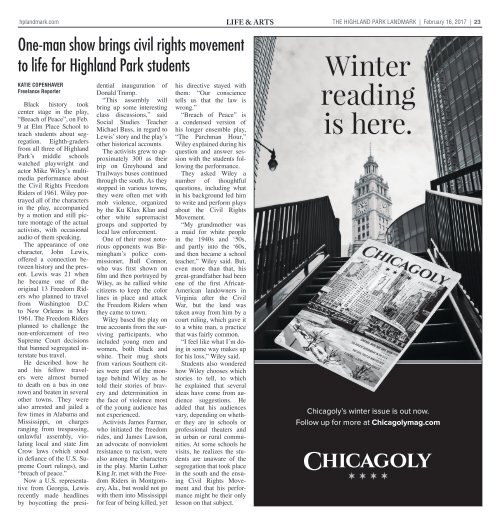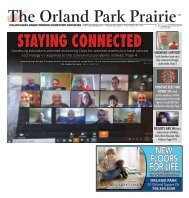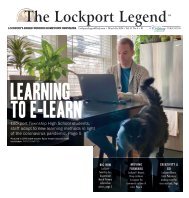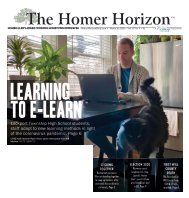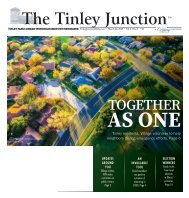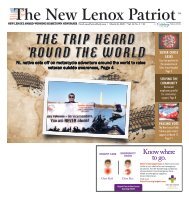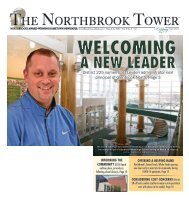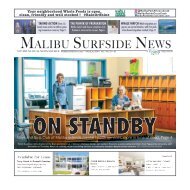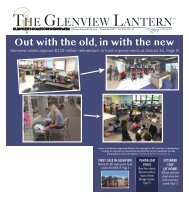HP_021617
The Highland Park Landmark 021617
The Highland Park Landmark 021617
You also want an ePaper? Increase the reach of your titles
YUMPU automatically turns print PDFs into web optimized ePapers that Google loves.
hplandmark.com life & arts<br />
the highland park landmark | February 16, 2017 | 23<br />
One-man show brings civil rights movement<br />
to life for Highland Park students<br />
Katie Copenhaver<br />
Freelance Reporter<br />
Black history took<br />
center stage in the play,<br />
“Breach of Peace”, on Feb.<br />
9 at Elm Place School to<br />
teach students about segregation.<br />
Eighth-graders<br />
from all three of Highland<br />
Park’s middle schools<br />
watched playwright and<br />
actor Mike Wiley’s multimedia<br />
performance about<br />
the Civil Rights Freedom<br />
Riders of 1961. Wiley portrayed<br />
all of the characters<br />
in the play, accompanied<br />
by a motion and still picture<br />
montage of the actual<br />
activists, with occasional<br />
audio of them speaking.<br />
The appearance of one<br />
character, John Lewis,<br />
offered a connection between<br />
history and the present.<br />
Lewis was 21 when<br />
he became one of the<br />
original 13 Freedom Riders<br />
who planned to travel<br />
from Washington D.C<br />
to New Orleans in May<br />
1961. The Freedom Riders<br />
planned to challenge the<br />
non-enforcement of two<br />
Supreme Court decisions<br />
that banned segregated interstate<br />
bus travel.<br />
He described how he<br />
and his fellow travelers<br />
were almost burned<br />
to death on a bus in one<br />
town and beaten in several<br />
other towns. They were<br />
also arrested and jailed a<br />
few times in Alabama and<br />
Mississippi, on charges<br />
ranging from trespassing,<br />
unlawful assembly, violating<br />
local and state Jim<br />
Crow laws (which stood<br />
in defiance of the U.S. Supreme<br />
Court rulings), and<br />
“breach of peace.”<br />
Now a U.S. representative<br />
from Georgia, Lewis<br />
recently made headlines<br />
by boycotting the presidential<br />
inauguration of<br />
Donald Trump.<br />
“This assembly will<br />
bring up some interesting<br />
class discussions,” said<br />
Social Studies Teacher<br />
Michael Buss, in regard to<br />
Lewis’ story and the play’s<br />
other historical accounts.<br />
The activists grew to approximately<br />
300 as their<br />
trip on Greyhound and<br />
Trailways buses continued<br />
through the south. As they<br />
stopped in various towns,<br />
they were often met with<br />
mob violence, organized<br />
by the Ku Klux Klan and<br />
other white supremacist<br />
groups and supported by<br />
local law enforcement.<br />
One of their most notorious<br />
opponents was Birmingham’s<br />
police commissioner,<br />
Bull Connor,<br />
who was first shown on<br />
film and then portrayed by<br />
Wiley, as he rallied white<br />
citizens to keep the color<br />
lines in place and attack<br />
the Freedom Riders when<br />
they came to town.<br />
Wiley based the play on<br />
true accounts from the surviving<br />
participants, who<br />
included young men and<br />
women, both black and<br />
white. Their mug shots<br />
from various Southern cities<br />
were part of the montage<br />
behind Wiley as he<br />
told their stories of bravery<br />
and determination in<br />
the face of violence most<br />
of the young audience has<br />
not experienced.<br />
Activists James Farmer,<br />
who initiated the freedom<br />
rides, and James Lawson,<br />
an advocate of nonviolent<br />
resistance to racism, were<br />
also among the characters<br />
in the play. Martin Luther<br />
King Jr. met with the Freedom<br />
Riders in Montgomery,<br />
Ala., but would not go<br />
with them into Mississippi<br />
for fear of being killed, yet<br />
his directive stayed with<br />
them: “Our conscience<br />
tells us that the law is<br />
wrong.”<br />
“Breach of Peace” is<br />
a condensed version of<br />
his longer ensemble play,<br />
“The Parchman Hour,”<br />
Wiley explained during his<br />
question and answer session<br />
with the students following<br />
the performance.<br />
They asked Wiley a<br />
number of thoughtful<br />
questions, including what<br />
in his background led him<br />
to write and perform plays<br />
about the Civil Rights<br />
Movement.<br />
“My grandmother was<br />
a maid for white people<br />
in the 1940s and ‘50s,<br />
and partly into the ‘60s,<br />
and then became a school<br />
teacher,” Wiley said. But,<br />
even more than that, his<br />
great-grandfather had been<br />
one of the first African-<br />
American landowners in<br />
Virginia after the Civil<br />
War, but the land was<br />
taken away from him by a<br />
court ruling, which gave it<br />
to a white man, a practice<br />
that was fairly common.<br />
“I feel like what I’m doing<br />
in some way makes up<br />
for his loss,” Wiley said.<br />
Students also wondered<br />
how Wiley chooses which<br />
stories to tell, to which<br />
he explained that several<br />
ideas have come from audience<br />
suggestions. He<br />
added that his audiences<br />
vary, depending on whether<br />
they are in schools or<br />
professional theaters and<br />
in urban or rural communities.<br />
At some schools he<br />
visits, he realizes the students<br />
are unaware of the<br />
segregation that took place<br />
in the south and the ensuing<br />
Civil Rights Movement<br />
and that his performance<br />
might be their only<br />
lesson on that subject.<br />
Winter<br />
reading<br />
is here.<br />
Chicagoly’s winter issue is out now.<br />
Follow up for more at Chicagolymag.com


